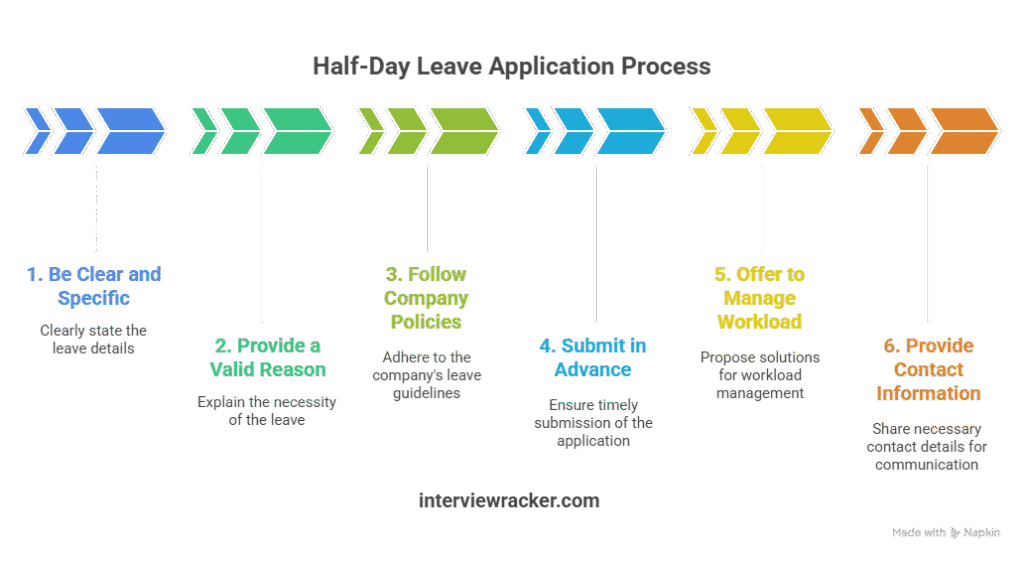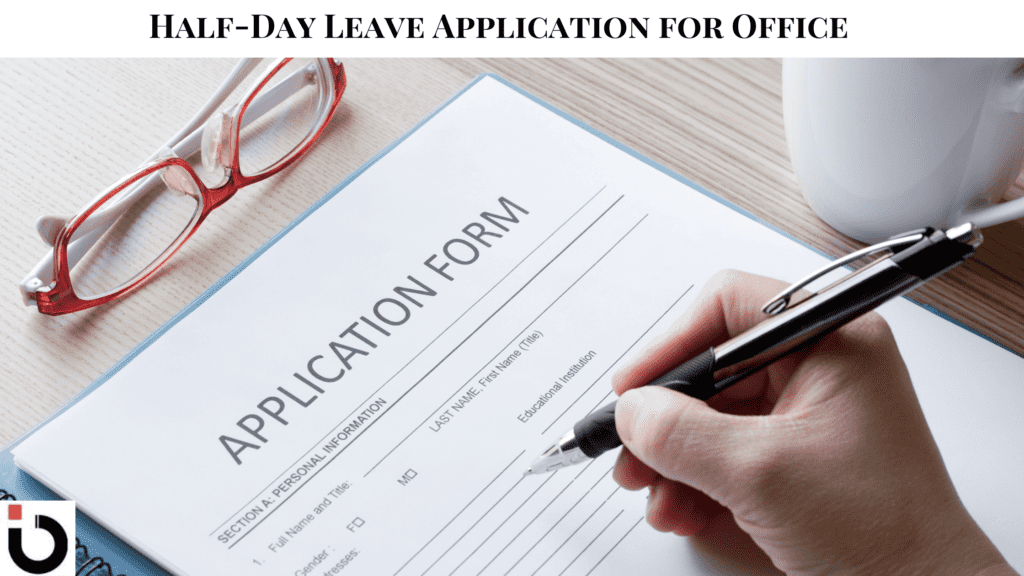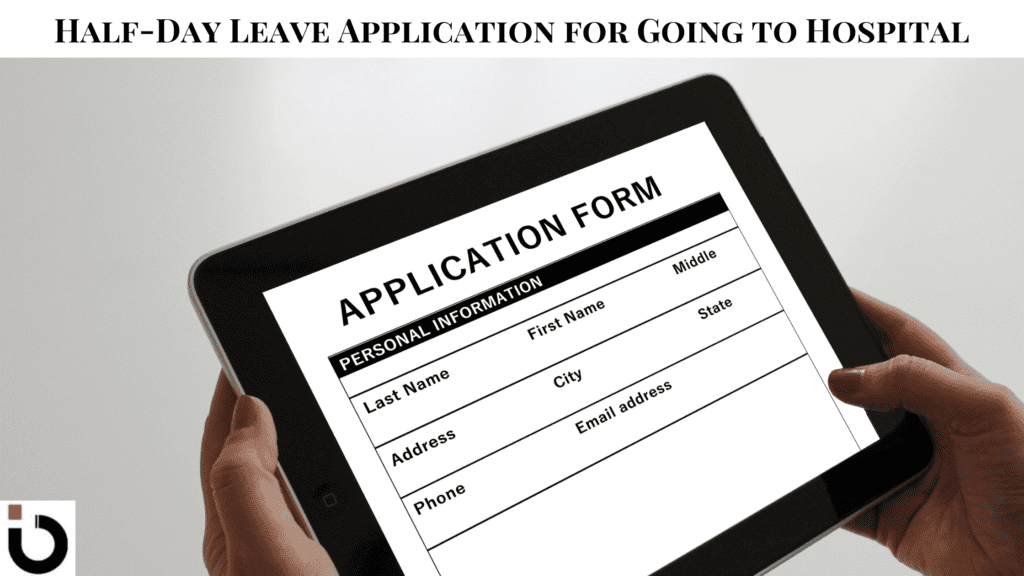Sometimes, unexpected situations arise where you need to step away from work for a few hours, whether it’s for a personal commitment, a medical appointment, or an urgent errand. In such cases, a half day leave application helps you formally request time off while ensuring minimal disruption to your workflow. Crafting a clear and professional leave request is essential to maintaining transparency and professionalism at work.
In this blog, I’ll share how to write an effective half-day leave application with examples to make the process easier.
Table of Contents
ToggleKey Takeaways / TL;DR
Requesting a half-day leave, whether for office or school, requires a clear, professional, and policy-compliant approach. Here are the essential points:
Common Reasons: Half-day leaves are typically for personal appointments, family matters, well-being, special events, emergencies, or mental health.
Clarity is Key: Always be specific with the date and exact times you will be absent.
Reason (Brief & Valid): Provide a concise and valid reason, but avoid unnecessary details.
Follow Policy: Adhere strictly to your company’s or school’s official leave policies, including notice periods and approval processes.
Submit in Advance: Whenever possible, submit your request with ample notice to allow for proper planning and coverage.
Manage Workload: Offer to complete urgent tasks before leaving or arrange for colleagues to cover your responsibilities.
Professional Tone: Maintain a respectful and professional demeanor in all communications.
Understand Deduction: Be aware if your half-day leave is deducted as a fixed unit (e.g., 4 hours) or precise hours absent from your PTO.
Know Your Handbook: Your employee handbook or HR policy document is the definitive source for rules on PTO vs. unpaid leave, notice periods, and more.
Legal Awareness: Be mindful that labor laws (e.g., FLSA in the US, Working Time Regulations in the UK) can influence how leave is managed, particularly regarding exempt vs. non-exempt employees.
When Do You Need a Half-Day Leave?
First, let’s understand the reasons we need to apply for a half day’s leave. There are various reasons why an individual may request a half-day leave from the office, school, or college.
Some possible reasons include:
1. Personal Appointments:
Attending medical appointments, dental visits, or other personal appointments that cannot be scheduled outside of working hours.
2. Family Obligations:
Attending to family matters such as caring for a sick child or accompanying a family member to a medical appointment.
3. Personal Well-being:
Taking time off for self-care or to attend to personal matters that require immediate attention.
4. Work-Life Balance:
Making time for personal activities, relaxation, or pursuing hobbies to maintain a healthy work-life balance.
5. Special Events:
Attending special events or ceremonies, such as graduations, weddings, or religious observances.
6. Personal Development:
Participating in training sessions, workshops, or seminars to enhance professional skills or knowledge.
7. Emergency Situations:
Dealing with unexpected emergencies or urgent matters that require immediate attention.
8. Mental Health:
Taking time off to address mental health concerns, recharge, or seek support from mental health professionals.
It’s important for individuals to communicate their reasons for requesting a half-day leave transparently and in accordance with their organization’s policies and procedures. Additionally, providing advance notice whenever possible and coordinating with colleagues to minimize disruption to workflow are considered best practices when requesting time off.
How to Write the Perfect Half-Day Leave Application in 6 Steps

Writing a half-day leave application requires clarity, professionalism, and consideration of your organization’s policies. Here are some things to take care of while writing a half-day leave application:
1. Be Clear and Specific:
Clearly state the date and whether you are requesting a half-day leave for the morning or afternoon session.
2. Provide a Valid Reason:
Clearly explain the reason for your leave in a concise manner. It could be for personal appointments, family obligations, medical reasons, or other valid reasons.
3. Follow Company Policies:
Familiarize yourself with your organization’s leave policies, including the procedure for requesting leave and any specific documentation required.
4. Submit in Advance:
Submit your leave application well in advance, preferably according to the timeline specified by your organization’s policies unless its emergency.
5. Offer to Manage Workload:
Assure your supervisor that you will complete pending tasks before your departure and ensure a smooth handover of any ongoing projects.
6. Provide Contact Information:
Include your contact information in case your supervisor needs to reach you during your absence.
Extra Tips:
7. Professional Tone:
Maintain a professional tone throughout the application. Avoid unnecessary details and stick to the point. Read the application out loud to spot and rephrase any awkward wording.
8. Follow-Up:
Follow up with your supervisor to ensure that your leave request has been received and approved.
9. Respect Confidentiality:
Maintain confidentiality regarding the reason for your leave, especially if it involves personal or medical matters.
10. Be Grateful:
Express gratitude for your manager’s consideration of your leave request.
By following these guidelines, you can ensure that your half-day leave application is clear, professional, and respectful of company policies and procedures.
Sample Applications for Half Day Leave

Half Day Leave Application for Personal Reason
Subject: Half-Day Leave Application for Personal Reasons
Dear [Manager’s Name],
I hope this message finds you well.
I am writing to request a half-day leave on [Date] due to personal reasons that require my attention. I would like to leave [in the morning/afternoon] to attend to [briefly explain the nature of the personal reason, such as a family matter, appointment, or personal commitment].
I assure you that I will complete all pending tasks before my departure and will ensure that any ongoing projects are handed over smoothly to [name of colleague or team member who will cover for you, if applicable].
Thank you for considering my my half-day leave request.
Sincerely,
[Your Name]
How to Write an Application for Half-Day Leave in School /College?
There can be two scenarios here:
1. Half Day Leave Application For School Teacher to Principal | Half Day Leave Application For College Professor to Principal
Subject: Half-Day Leave Application for [Date]
Dear Principal [Principal’s Name],
I hope this message finds you well.
I am writing to request a half-day leave for [Date]. Due to [briefly explain the reason for your leave, such as a medical appointment, family obligation, personal commitment, etc.], I need to attend to an urgent matter during [morning/afternoon] hours.
I assure you that I will complete any pending tasks before my departure and will coordinate with my colleagues to ensure that any ongoing responsibilities or classes are addressed in my absence.
Thank you for considering my request.
Sincerely,
[Your Name]
2. Half-Day Leave Application For Student to Principal
The sample for writing a half day leave application for school is as below:
[Your Name]
[Class/Grade]
[School Name]
[Date]
To:
The Principal
[School Name]
[School Address]
Subject: Request for Half Day Leave
Respected Sir/Madam,
I am writing to inform you that I need to leave school early on [date] due to a [reason, e.g., medical appointment/family commitment]. I will attend the first half of the school day and complete any missed work the following day.
I kindly request you to grant me permission for a half-day leave. Your understanding and support in this matter would be greatly appreciated.
Thank you.
Yours sincerely,
[Your Name]
[Roll Number/Class]

Half-Day Leave Application for Office
Subject: Request for Half-Day Leave
Dear [Manager’s Name],
I hope you are doing well. I am writing to request a half-day leave on [date] due to [mention reason, e.g., personal work, urgent appointment, family commitment]. I will ensure that all my tasks are managed beforehand and will be available for any urgent matters if needed.
I would appreciate your approval of my request. Please let me know if any further information is required.
Thank you for your time and consideration.
Best regards,
[Your Name]
[Your Designation]
[Your Department]
Half-Day Leave Application for Urgent Work

Application for Half-Day Leave in School for Urgent Work:
Subject: Request for Half-Day Leave Due to Urgent Work
Dear [Teacher’s Name/Principal’s Name],
I hope you are doing well. I am writing to request a half-day leave on [date] as I have some urgent personal work that requires my immediate attention. I will attend the school in the morning and leave after [mention time, e.g., the lunch break].
I assure you that I will catch up on any missed lessons and complete my assignments on time. I would be grateful for your approval of my request.
Thank you for your understanding.
Sincerely,
[Your Name]
[Your Class/Section]
[Your Roll Number]
Application for Half-Day Leave in Office for Urgent Work:
Subject: Request for Half-Day Leave Due to Urgent Work
Dear [Manager’s Name],
I hope you are doing well. I am writing to request a half-day leave on [date] due to some urgent personal work that requires my attention. I will complete my pending tasks before leaving and ensure there is no disruption in workflow.
Please let me know if you need any further details. I would appreciate your approval of my request.
Thank you for your understanding.
Best regards,
[Your Name]
[Your Designation]
[Your Department]

Half-Day Leave Application for Going to the Hospital
Subject: Request for Half-Day Leave for Hospital Visit
Dear [Manager’s Name],
I hope you are doing well. I would like to request a half-day leave on [date] as I need to visit the hospital for a medical check-up. I will ensure that all my important tasks are managed before leaving and will be available for any urgent matters if needed.
I would appreciate your approval of my request. Please let me know if any further information is required.
Thank you for your understanding.
Best regards,
[Your Name]
[Your Designation]
[Your Department]
How to Ask for a Half-Day via Different Platforms
While a formal email might still have its place, the modern workplace utilizes a variety of communication tools. Knowing how to appropriately request a half-day across these platforms demonstrates your understanding of contemporary professional etiquette and helps your message land effectively.
Slack/Microsoft Teams: Quick, Professional, and Concise
For instant messaging platforms like Slack or Microsoft Teams, aim for a message that is brief, direct, and professional. The key is to convey your request clearly without unnecessary formalities.
Here’s an example:
“Hi [Manager’s Name], I’d like to request a half-day off on [Date], from [Start Time] to [End Time]. I’ll ensure all my urgent tasks are completed before then. Thanks!”
Why it works: It’s to the point, specifies the crucial details, and shows consideration for your responsibilities.
Official HRIS/HRM Software (e.g., Workday, BambooHR)
Human Resources Information Systems (HRIS) or Human Resources Management (HRM) software are increasingly common for leave requests. These portals often have specific fields and sometimes character limits for the “reason” or “notes” section.
When using these platforms:
Be precise with dates and times: Ensure you accurately select the half-day option or input the correct hours.
Keep your “reason” concise: If there’s a character limit, prioritize the core information. A simple “Personal Appointment” or “Family Matter” is often sufficient. If your company culture allows for more detail, you can briefly elaborate, e.g., “Attending a medical appointment.”
Double-check your submission: Before finalizing, review all entered information to avoid errors.
Why it matters: Using these systems correctly ensures your request is formally logged and routed to the appropriate channels, streamlining the approval process.
Formal Email: When Tradition Still Holds Value
While not always the first choice, a formal email remains a valid and often necessary method for requesting a half-day, especially in more traditional environments or for specific types of leave. Your existing content on formal email requests is excellent and should be presented as a robust option within your comprehensive guide.
Key elements of a formal email for a half-day request:
Clear subject line: “Half-Day Leave Request – [Your Name] – [Date]”
Polite salutation: Address your manager or HR representative directly.
Concise request: State the specific date and time for your half-day.
Brief reason (optional, depending on company policy): A general reason like “personal appointment” or “to attend to a family matter” is usually sufficient.
Assurance of work coverage: Briefly mention how you plan to manage your responsibilities.
Professional closing: “Sincerely” or “Regards.”
Understanding Your Company's Half-Day Leave Policy
While our previous sections offered practical advice for requesting a half-day, truly mastering the process requires a deeper dive into the specific policies governing leave at your workplace. This isn’t just about following rules; it’s about safeguarding your Paid Time Off (PTO), avoiding misunderstandings, and demonstrating a high level of professionalism. Disregarding these nuances can lead to unexpected deductions or even policy violations.
Your Employee Handbook: Your Ultimate Guide
The single most important resource for understanding half-day leave at your company is your employee handbook or HR policy document. This comprehensive guide will detail the specifics relevant to your organization. Don’t skip this step! It’s where you’ll find answers to critical questions like:
Paid Time Off (PTO) vs. Unpaid Leave: Does your company offer a dedicated bank of PTO that can be used for half-days, or will a half-day automatically be considered unpaid leave? Understanding this distinction is vital for managing your earnings and available time off. Some companies might have separate accruals for sick leave and vacation leave, with specific rules on how a half-day might be deducted from either.
Notice Period Requirements: How much advance notice does your company require for a half-day leave request? While a sudden illness might warrant immediate notification, planned appointments usually come with a minimum notice period (e.g., 24 hours, 48 hours, or even a week). Adhering to these periods demonstrates respect for your team and manager’s planning.
Deduction Method: Hours vs. Half-Day Unit: This is a crucial detail often overlooked. Does your company deduct a half-day as a fixed block (e.g., 4 hours, regardless of your actual working hours that day), or is it deducted precisely by the number of hours you’re absent (e.g., if you leave 2.5 hours early, only 2.5 hours are deducted from your PTO)? Clarifying this ensures you don’t overspend your valuable leave balance.
Approval Process and Escalation: Who needs to approve your half-day leave? Is it just your direct manager, or does it require HR approval too? What’s the protocol if a request is denied, and is there an escalation path?
Legal Nuances and Global Considerations
While we cannot provide legal advice, it’s important to be aware that labor laws can significantly impact leave policies, especially in different countries. Understanding these broad strokes elevates your content from generic advice to a genuinely authoritative resource.
United States – Fair Labor Standards Act (FLSA): The FLSA primarily governs minimum wage, overtime pay, recordkeeping, and child labor standards. While it doesn’t mandate paid leave, it does impact how leave is managed, particularly for exempt vs. non-exempt employees. For instance, if an exempt employee takes a half-day, employers generally cannot deduct from their salary for partial-day absences if they perform any work during the week, without jeopardizing their exempt status. Non-exempt employees, paid hourly, are typically paid only for hours worked, so a half-day absence simply means fewer hours to be paid.
United Kingdom – Working Time Regulations: In the UK, workers are entitled to paid annual leave. While specific half-day rules aren’t directly legislated, how half-day absences integrate with an employer’s overall leave policy (which must comply with statutory annual leave entitlements) is important.
Canada – Provincial and Federal Labour Codes: Leave entitlements in Canada vary significantly by province and territory, and by federal jurisdiction. Each region will have its own rules regarding minimum paid leave, sick leave, and how partial days off might be handled.
Australia – National Employment Standards (NES): The NES outline minimum employment entitlements for employees in Australia, including paid annual leave and personal/carer’s leave. Companies must have policies that adhere to these standards, and how half-day leave is managed will typically fall under these broader entitlements.
For Managers: Effectively Handling Half-Day Leave Requests
As a manager, efficiently handling half-day leave requests is crucial for maintaining team productivity, morale, and fairness. Approving, denying, or seeking more information requires a thoughtful approach that balances business needs with employee well-being. By understanding best practices, you can streamline this process and foster a positive work environment.
Approving a Half-Day Leave Request
When an employee submits a half-day leave request, consider the following before giving your approval:
Team Coverage: Is there adequate coverage for essential tasks during the employee’s absence? Can other team members temporarily take over responsibilities, or can the employee complete critical work before leaving?
Workload Impact: Will the absence significantly disrupt ongoing projects or deadlines? If the impact is minimal, approval is often straightforward.
Employee’s History: Does the employee have a history of responsible leave usage? A reliable employee who plans ahead makes the decision easier.
Fairness and Consistency: Ensure your decision aligns with company policy and how you’ve handled similar requests from other team members. Inconsistent approvals can lead to resentment.
If all looks good, a simple, clear approval is best. For example: “Hi [Employee Name], I approve your half-day leave request for [Date], from [Start Time] to [End Time]. Please ensure your urgent tasks are completed before you leave.”
Denying a Half-Day Leave Request
There are times when denying a half-day request is necessary. Transparency and clear communication are vital here to avoid demotivating your team member.
State the Reason Clearly: Be specific about why the request cannot be approved. This could be due to critical deadlines, insufficient team coverage, or a conflict with company policy. Vague denials can cause frustration.
Offer Alternatives: If possible, suggest alternative dates or times for the half-day leave. “Unfortunately, I can’t approve your half-day request for [Date] due to [reason, e.g., ‘the upcoming project deadline on X’]. Would [Alternative Date] or a different time work for you instead?”
Refer to Policy: If the denial is policy-related (e.g., too many team members on leave, insufficient notice), politely refer the employee to the relevant company guidelines.
Maintain Professionalism: Even if the denial is difficult, keep the tone respectful and empathetic.
Requesting More Information
Sometimes, a leave request might lack sufficient detail, or you might need clarification before making a decision.
Be Specific in Your Questions: Instead of a generic “Why do you need time off?”, ask targeted questions like, “Could you elaborate on the tasks you plan to complete before leaving?” or “Are there any urgent client meetings scheduled for that afternoon?”
Understand the “Why” (if appropriate): While you don’t need to pry into personal matters, understanding the general reason can help you assess urgency and potential flexibility. For instance, a medical appointment might be less flexible than a personal errand.
Set Expectations for Response Time: Let the employee know when you need the additional information to make a timely decision.
Documentation and Company Policy
Familiarize Yourself with HRIS/HRM Systems: Understand how to process approvals, denials, and notes within your company’s official HR software (like Workday or BambooHR). Proper documentation is key for compliance and record-keeping.
Adhere to Company Policy: Always ensure your decisions align with your company’s established leave policies regarding notice periods, reasons for leave, and maximum leave days.
Keep Records: Regardless of the platform used for the initial request (email, Slack, HRIS), ensure all decisions are formally documented in the appropriate system.
By implementing these strategies, managers can handle half-day leave requests with confidence, fostering a productive and respectful workplace culture.
Related Professional Development Tools: Empowering Your Half-Day Leave Strategy
Successfully integrating half-day leaves into your professional life isn’t just about writing a good application; it’s about effective planning, seamless communication, and demonstrating a high level of responsibility. The right professional tools can be your greatest allies in achieving this, turning a potentially complex request into a smooth, well-managed process.
This section highlights key software and platforms that can directly help you manage your workload around a half-day, communicate clearly, and even enhance your skills for greater workplace flexibility. Investing in these tools can not only make your half-day requests effortless but also boost your overall professional standing.
1. Time Management & Productivity Software: Master Your Schedule
How they help with half-day leave: These tools are crucial for ensuring that your work is completed efficiently before you step away for a half-day. They help you visualize your tasks, prioritize what’s urgent, and even track your productive hours, allowing you to confidently assure your manager that your absence won’t derail critical projects.
For Task & Project Organization: Tools like Asana, Trello, or ClickUp allow you to create detailed to-do lists, set deadlines, and delegate tasks. Before your half-day, you can use them to update project statuses, assign urgent items to colleagues, and ensure continuity.
For Personal Time Tracking & Focus: Platforms such as Clockify, Toggl Track, or RescueTime help you understand how you spend your time. This insight is invaluable for demonstrating efficiency and proving that you can manage your responsibilities effectively, even when adjusting your hours.
2. Communication & Collaboration Platforms: Communicate Your Absence Clearly
How they help with half-day leave: Effective communication is the cornerstone of a smooth half-day leave request. These platforms provide the necessary channels to send professional notifications, get quick approvals, and coordinate seamlessly with your team.
For Instant Messaging & Team Spaces: Slack and Microsoft Teams are ideal for sending quick, professional messages to your manager and team about your half-day. Many also offer integrations with leave management systems (like Deel or Vacation Tracker) that allow you to request time off directly within the chat interface, simplifying the process and ensuring visibility.
For Virtual Meetings & Handovers: Zoom and Google Meet enable quick virtual check-ins or handover discussions with colleagues before your departure, ensuring everyone is on the same page and responsibilities are clear.
3. HR & Leave Management Systems: Navigate Policy with Ease
How they help with half-day leave: These specialized HR software solutions are often the official gateway for submitting and tracking leave. They are indispensable for adhering to company policy, monitoring your leave balance, and ensuring your half-day request is formally documented.
For Centralized Leave Requests & Tracking: Systems like Workday, BambooHR, Zoho People, or Keka HR are where you’ll typically submit your formal half-day request. They provide an intuitive interface to select dates, specify times, and often show your remaining PTO balance. These systems ensure your request is routed to the correct approver and maintains a digital record, reducing the chance of miscommunication.
4. Online Learning & Skill Development Platforms: Boost Your Value & Flexibility
How they help with half-day leave: While not directly used for requesting leave, investing in these platforms enhances your overall professional value and can make your requests for flexibility more readily accommodated. A highly skilled and reliable employee is often granted more leeway.
For Career Advancement & New Skills: Platforms such as Coursera, edX, or Udemy offer courses that can help you acquire new skills or certifications. Demonstrating continuous professional development reflects positively on your commitment and can make you a more indispensable team member, indirectly supporting your ability to manage your schedule effectively.
By strategically utilizing these professional tools, you’re not just asking for a half-day; you’re demonstrating your commitment to efficiency, clear communication, and continuous improvement. Explore the options that best suit your professional journey and empower yourself to manage your work and personal life with greater ease.
FAQs on Half-Day Leaves
How do I apply for a half-day leave?
To apply for a half-day leave, follow your organization’s established procedure, which may involve submitting a written or verbal request to your supervisor or through an internal system. Ensure you provide adequate notice and specify the reason for your leave.
Can I take a half-day leave for personal reasons?
Yes, many organizations allow employees to take half-day leaves for personal reasons, such as medical appointments or family commitments. It’s important to communicate your needs clearly and adhere to company policies regarding leave.
Does a half-day leave affect my pay?
The impact of a half-day leave on your pay depends on your employment terms and the organization’s leave policies. If you have accrued paid leave, a half-day may be deducted from your balance without affecting your pay. For unpaid leave, your pay may be adjusted accordingly.
How does taking a half-day leave affect my attendance record?
Taking a half-day leave is typically recorded in your attendance record but is generally not viewed negatively if used appropriately and in accordance with company policies. It’s advisable to use such leaves judiciously and maintain open communication with your employer.
Is there a limit to how many half-day leaves I can take?
Limits on half-day leaves vary by organization. Some companies may have specific policies outlining the number of half-day leaves permitted within a certain period, while others may handle requests on a case-by-case basis. Consult your employee handbook or HR department for details.
Please note that policies regarding half-day leave can differ between organizations and countries. It’s essential to familiarize yourself with your company’s specific guidelines and local labor laws.









